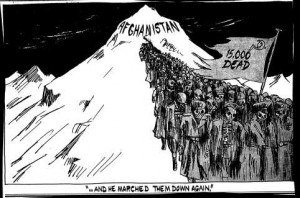The ‘Dead Hand’ in Afghanistan |
|
 Explanation of Bibliography Title |
|
Introduction |
Early Russian Terrorism |
1979 Invasion |
Support of Terrorism |
IntroductionFor the last four decades, Afghanistan has been in a constant state of war and disarray. The condition of the Afghani government and society has increased the proliferation of fundamentalist Islamic groups, like Al Qaeda. Russian influence- past and present- contributed greatly to the current state of Afghanistan. Russia has influenced Afghanistan both directly and indirectly. In particular, three different moments of Russian history have led to the creation of today’s Afghanistan: the values of Early Russian Terrorism, the 1979 Soviet Invasion of Afghanistan, and Russia’s Support of Terrorism. The historiography of Russia’s impact on Afghanistan has examined each of these moments individually; this is the first time that these separate instances have been brought together by one thesis. History never occurs in a vacuum, and the formation of present-day Afghanistan is no exception. A strong counter-thesis would contest that many unrelated factors contributed to the formation of present-day Afghanistan, and the blame for Afghanistan’s instability could easily fall on other world powers such as the United States. Those counter-arguments would be eagerly entertained and may even be correct; however, those counter-arguments would neglect the greater objective of this work. Russia is not the only world actor with Afghan blood on their hands, but Russia’s notable impact on Afghanistan warrants deeper research. This work intends to identify and explain how events in Russia’s past are reflected in the pools of Afghan blood. |
|||
Early Russian TerrorismDespite Western Society’s skewed perception, terrorism did not even originate in the Middle East. The word ‘Terrorism” originates from the reign of the post-French Revolution reign of the Jacobins; the Jacobins would guillotine their opposition in order to maintain their control over French Society (1793-1794). Today’s definition of “Terrorism” originated from the actions of Russian Anarchist Revolutionaries. During the late 1800s, the People’s Will tried to assert a ‘blow to the center’ of the Russian Tsar regime by assassinating Tsar Alexander II. Beyond assassinations and attacks, the People’s Will gained attention and support through an intensive propaganda machine. The People’s Will embraced a culture of self-sacrifice and emphasized that group members willing to die for the cause were martyrs and heroes. Since the late 1800s, terrorist groups have used the methods, targets, propaganda, and ideological framework of the early Russian revolutionaries. The primary and secondary sources below provide greater insight into the impact of Early Russian Terrorism. These sources demonstrate that ‘terrorism’ was not created by the Quran, but rather adopted by weak groups trying to damage stronger powers. In addition these sources assert that the techniques seen today- by groups like Al Qaeda-originated in Russia. PrimaryAl Qaeda. “Declaration of Jihad Against the Country’s Tyrants.” US Department of Justice. US Department of Justice, July 2005. Web. Link to the US Department of Justice PDF. Al Qaeda’s “Declaration of Jihad Against the Country’s Tyrants” is an extraordinary primary source that allows a reader to observe the mission and tactics of Al Qaeda. In addition, this primary source allows the reader to compare Al Qaeda’s mission and tactics to the mission and tactics of 19th century Russian Revolutionaries. SecondaryBenjamin, Daniel, and Steven Simon. The Age of Sacred Terror. New York: Random House, 2002. In The Age of Sacred Terror , Daniel Benjamen and Steven Simon examine Radical Islamic terrorist attacks against America, the response of the US, and the failures of the US intelligence community. In doing so, Benjamen and SImon review the history that led to the radicalization of Islam, and the major radical Islamic figures. Ultimately, the work argues that terrorism is not an inherent trait of Islam; rather, terrorism is a tactic that Radical Islamic Groups have adapted overtime, in order to try to gain ground against stronger opposition. Carr, Matthew. The Infernal Machine: A History of Terrorism From the Assassination of Tsar Alexander II to Al-Qaeda. New York: The New Press, 2007. In Matthew Carr’s The Infernal Machine: A History of Terrorism From the Assassination of Tsar Alexander II to Al Qaeda, Carr explains the evolution of ‘terrorism’ from the 19th century Russian Revolutionaries to present-day Al Qaeda. Carr’s in-depth analysis of both Russian Revolutionaries and Radical Islamic Terrorists allows the reader to understand each group individually and to identify the common traits between the groups. |
|||
1979 InvasionOn December 24 1979, the Soviet Union invaded Afghanistan. The Soviet Union’s actions in Afghanistan demonstrated that they wanted to transform Afghanistan into a Communist State and exploit Afghanistan for their resources. The USSR tore through Afghanistan destroying infrastructure, killing civilians, and instituting Soviet policies. The Soviet aggression caused the United States to create a covert action program that was designed to radicalize the Mujahideen Muslims against the Soviets. When the Soviets finally pulled out in February 1989, Afghanistan was socially, economically, and physically decimated. The weakness of the Afghan government allowed extremists and terrorists to enter the country and gain power. The Soviet imperialism provided terrorist groups like Al Qaeda with an inspiration and impetus for their actions against ‘colonial tyrants.’ The invasion left a lasting impression on the infrastructure of Afghanistan and paved the way for the proliferation of Radical Islamic Terrorist Groups. PrimaryGarland, Nicholas, “And He Marched Them Down Again,” The Independent, May 20, 1988. Nicholas Garland’s cartoon depicts the withdrawal of the Soviet forces from Afghanistan. The cartoon is a very compelling primary source, because it captures the tone and flavor of the Soviet occupation of Afghanistan: bleak and destructive. SecondaryCourtois, Stephane, Nicholas Werth, Jean-Louis Panne, Andrzej Paczkowski, Karel Brtosek, and Jean-Louis Margolin. The Black Book of Communism. Cambridge, MA: Harvard University Press, 1999. The Black Book of Communism details the development of Communism from Lenin to the Soviet Invasion of Afghanistan. More specifically, the authors emphasize the criminal and corrupt aspects of Communism, and furthermore, they attempt to answer the question, ‘Why did Communism turn into an ideology of dictatorship and corruption?’ Peer-Reviewed JournalsOleinik, Anton. 2008. “Lessons of Russia in Afghanistan.” Society 45, no. 3: 288-293. Religion and Philosophy Collection, EBSCOhost. In “Lessons of Russia in Afghanistan,” Anton Oleinik discusses the relative history of Afghanistan, and in particular he studies the impact of combining traditional Afghani values with new institutions. He uses the Soviet Invasion of Afghanistan as a case study to demonstrate why Afghanistan struggles to embrace and assimilate new institutions. The journal presents great insight and documentation of the Afghani struggle against the Soviet Union. |
|||
Support of TerrorismSecondary SourcesCorera, Gordon. Shopping for Bombs . New York: Oxford University Press, 2006. Gordon Corera explains how nuclear technology made its way to Iran, North Korea, and Libya. He also describes the actions of A.Q. Khan, and his role in the illegal spread of nuclear technology. In addition, Corera describes the actions of other arms-trade actors like Russia, and how their actions led to further nuclear proliferation. Peer-Reviewed JournalElad, Shlomi and Ariel Merari. “The Soviet Bloc and World Terrorism.” Jaffee Center for Strategic Studies Paper No. 26: (August 1984). Shlomi Elad and Ariel Merari examine the Soviet Bloc’s connections to World Terrorism. First, the study defines terrorism and explains the The study examines the many factors of creating a ‘terrorist infrastructure,’ and explains how the Soviet Union created and maintained terrorist infrastructures through many different channels of support. In addition, the study explains the Soviet motives for supporting terrorist groups, and also explains how Russia is able to contribute to these terrorist infrastructures under the radar. Ultimately, the authors contest that the Soviet Union was able to successfully support terrorist groups as part of a strategic move to promote Soviet interests and strengthen Soviet economics. Yanik, Lerna K. 2006. “Guns and Human Rights: Major Powers, Global Arms Transfers and Violations.” Human Rights Quarterly 28, no. 2. Lerna Yanik examines the transfers of arms between major powers and countries with human rights violations. She reviews the international laws regarding arms transfers, and she explains the loop holes that allow these arms transfers to take place. Ultimately, she determines why major powers are transferring arms to human rights violators. |
|||
Explanation of TitleThe Soviet Union’s Dead Hand was part of the Soviet nuclear deterrence system during the Cold War; if the Soviet Union were under nuclear attack, the Dead Hand would be automatically launched by a computer system. The bibliography title is meant to be a play-on-words. This blog demonstrates how Russia’s influence on Afghanistan led to the creation of today’s Afghanistan. It is clear that Russia had a ‘hand’ in the formation of today’s Afghanistan; the destructive nature of Russia’s ‘hand’ in Afghanistan is akin to the potential destruction of the Soviet Era Dead Hand. |
|||
| Bibliography and Web Design by Kerrin Sperry | |||
